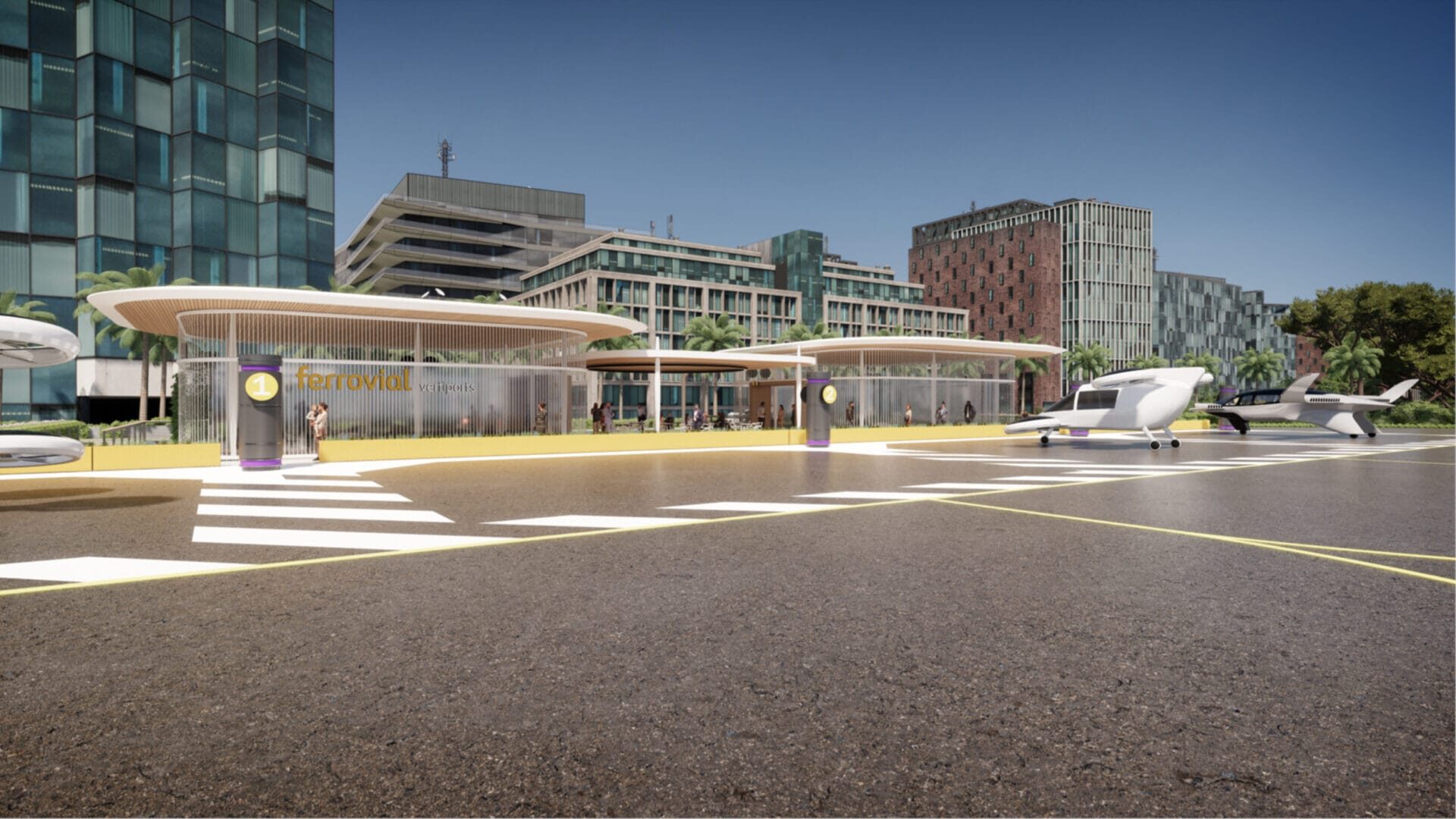
Critical elements of a vertiport and why sustainability is essential for their success
15 of February of 2023
Anything that takes off should have a safe place to land. This simple concept is the foundation of Advanced Urban Air Mobility’s need for critical infrastructure more commonly known in the industry as a “vertiport.”. And, just as there are multiple types of electric vertical take-off and landing aircraft (eVTOLs) making their way through development and certification, vertiports themselves will inevitably come in various sizes and locations.
This is precisely why we’re committed to building vertiports that are “agnostic” to any particular business model, operator, or aircraft type. With that said, we also firmly believe that there are common “elements” that must be considered and included in any design to enhance the overall operations, customer experience, and community adoption.
In its simplest terms, a vertiport can be divided into two main functional areas: Landside and Airside.
Airside of a vertiport
Let’s talk about the airside portion of a vertiport first. This is where the aircraft will takeoff, land, recharge, taxi or be towed to the stand, and, in some cases, receive light maintenance. It is also the area where the passengers will embark and disembark the aircraft.
Designs for the airside elements of our vertiport will mostly be driven by regulatory and safety factors, just as they are at an airport. These factors include space between eVTOLs, distance of the landing area from the gate, ability to safely recharge, and the airspace they can operate into and out of safely, efficiently, and effectively.
We expect our vertiports to have range between two to eight stands (think gates or aircraft parking positions), depending on the demand, the availability of land, the cost to build, and the cost to operate each vertiport. Given the size of the aircraft, the weight, and most importantly, the ability of the aircraft to take off and land vertically, we anticipate a vertiport can be constructed on anywhere from one to three acres of land. Quite compact, when you consider most commercial airports have been constructed on hundreds of acres of land.
These airside areas must be able to withstand the high-volume operations expected of the eVTOL aircraft, the thrust upon departure and arrival, as well as the overall weight and size of the aircraft. We are also considering various options for surfaces that assist in capturing and reusing rainwater and those that can in aid damping the noise generated by the aircraft, even though they are already considerably quieter than helicopters or fixed-wing aircraft.
Other important elements on airside include:
- Power and Charging infrastructure: eVTOL aircraft require significant battery power to take off and land, so vertiports must have the necessary power running into and through the facility, along with the associated charging infrastructure to keep the aircraft powered.
- Weather considerations: Vertiports need to be designed to operate in, and protect aircraft and passengers from, inclement weather.
- Safety and security systems: Vertiports need to have security measures in place to protect passengers, ground crew and aircraft to prevent unauthorized access to the airside.
- Noise reduction: While eVTOLs are significantly quieter than traditional aircraft or helicopters, noise reduction materials and measures can further minimize the impact on the surrounding community.

Landside of a vertiport
Turning to the landside, the common elements will include a passenger terminal and the “curbside” area where passengers enter and depart the vertiport. Two crucial elements similar to today’s airports, but also two areas where a vertiport can differentiate itself by providing a more efficient and arguably better customer experience.
Since eVTOLs will initially carry smaller numbers of passengers while operating a high volume of flights, there isn’t a need for a large, sprawling building. In fact, depending on the number of stands, the facilities could range in size from a 1500 to 3500 square feet. And, because part of the promise of Urban Air Mobility is time savings, it’s important to recognize that there will be significantly shorter waiting times for passengers and thus less need for extra space or amenities such as larger restaurants or stores, although retail offerings are absolutely possible in certain destination locations.
We will employ the vast knowledge and experience that we have gained in developing and operating some of the largest airports in the world, as well as our utilizing our extensive expertise in enhancing the customer experience through the design, building and operations of these new facilities.
As an example, our vertiports will operate will using sunlight and other natural elements to create an energy-efficient infrastructure. Whenever and wherever possible external energy will come from environmentally friendly sources, allowing for zero carbon emissions to further enhance the sustainability of this new form of transportation.
Another important element of a Ferrovial vertiport will be the integration of advanced technologies. This includes the use of automation and artificial intelligence (AI) to streamline operations and provide passengers with a personalized experience. For example, it is expected that passengers will not only be able to utilize their smartphones, but also biometrics, and other digital platforms to check in, board their flight, track schedules in real-time, and arrange for first and last mile connections to seamlessly speed them onto their ultimate destination.
Common characteristics on landside include:
- Passenger waiting areas: Although wait times for flights are expected to be short, with operators targeting 15 minutes or less, vertiports still need to have comfortable waiting areas for passengers including amenities such as seating areas with ample charging stations for devices, restrooms, wi-fi, and possibly options for small footprint retail space.
- Security measures: Vertiports will have some security measures in place commensurate with the risk, but these are anticipated to be much less evasive and significantly less time consuming than currently experienced at traditional commercial airports.
- Technology-enhanced passenger experience: Including security, check-in and baggage handling, as well as automated flight status updates.
- Convenient access to where you are and where you want to go: The first and last mile of a vertiport experience must be quick, convenient, and cost effective. Thus, we are laser-focused on placing vertiports close to where the people are and where they want to be. By utilizing Big Data and our proprietary demand tool, we hope to allow customers the ability to, in many cases walk to their final destination. If not walkable, then the objective is to ensure quick access to a taxi, ride sharing services, or jump on other forms of public transportation to get to their destination. Similarly, wherever sufficient land is available, we anticipate having sufficient parking to allow customers to park your private vehicle next to the vertiport or utilize a valet service, to speed them on their way.
Sustainability at the core
Above all, and regardless of the size or location, sustainability is always going to be top of mind for us in the design, construction and operation of a vertiport network. As Urban Air Mobility is expected to become a major part of our transportation system in the future, it is important to ensure that the infrastructure we build today is able to support the future needs of the transportation system. That means future-proofing the vertiports in order to accommodate second, third and fourth generation aircraft not yet on the drawing boards, along with new, clean, and innovative forms of power such as Hydrogen.
It also means ensuring sustainability is at the core of everything we do. This includes using sustainable materials in the construction of the vertiport, using renewable energy sources, wherever possible to power the vertiport, and designing the vertiport to maximize the sustainability benefits for the local communities.
We have a team of experienced professionals who are dedicated to delivering the best possible experience for the passengers, eVTOL aircraft operators and the communities they are there to serve.
In sum, we are proud to be playing a key role in transforming the future of urban mobility. It is exciting to be at the forefront of this transportation revolution as we introduce sustainable, convenient vertiports that will ease congestion in urban cities and help protect the environment for decades to come.





There are no comments yet